
Light rail is a form of passenger urban rail transit that uses rolling stock derived from tram technology while also having some features from heavy rapid transit.
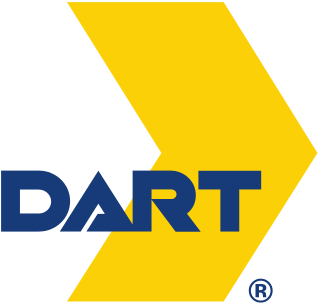
Dallas Area Rapid Transit (DART) is a transit agency serving the Dallas–Fort Worth metroplex of Texas. It operates buses, light rail, commuter rail, and high-occupancy vehicle lanes in Dallas and twelve of its suburbs. In 2023, the system had a ridership of 50,463,300, or about 166,700 per weekday as of the second quarter of 2024.
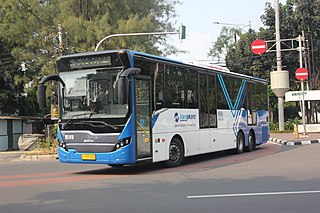
Bus rapid transit (BRT), also referred to as a busway or transitway, is a trolleybus, electric bus and public transport bus service system designed to have much more capacity, reliability, and other quality features than a conventional bus system. Typically, a BRT system includes roadways that are dedicated to buses, and gives priority to buses at intersections where buses may interact with other traffic; alongside design features to reduce delays caused by passengers boarding or leaving buses, or paying fares. BRT aims to combine the capacity and speed of a light rail transit (LRT) or mass rapid transit (MRT) system with the flexibility, lower cost and simplicity of a bus system.
A share taxi, shared taxi, taxibus, or jitney or dollar van in the US, or marshrutka in former Soviet countries, is a mode of transport which falls between a taxicab and a bus. Share taxis are a form of paratransit; they are vehicles for hire are typically smaller than buses and usually take passengers on a fixed or semi-fixed route without timetables, sometimes only departing when all seats are filled. They may stop anywhere to pick up or drop off their passengers. They are most common in developing countries or inner cities.

Lynx is a transit system serving the greater Orlando, Florida area. Operated by the Central Florida Regional Transportation Authority, it provides bus, curb-to-curb, and paratransit services in three counties: Orange, Seminole, and Osceola. Bus routes are referred to as Links.

Public buses form a significant part of public transport in Singapore, with over 3.6 million rides taken per day on average as of December 2021. There are 300+ scheduled bus services & 100+ short-trip variants, operated by SBS Transit, SMRT Buses, Tower Transit Singapore and Go-Ahead Singapore. The newest bus operator, Go-Ahead Singapore started operations on 4 September 2016. There are also around 5,800 buses currently in operation as of 2020.

Paratransit or intermediate public transport, is a type of transportation services that supplement fixed-route mass transit by providing individualized rides without fixed routes or timetables. Paratransit services may vary considerably on the degree of flexibility they provide their customers. At their simplest they may consist of a taxi or small bus that will run along a more or less defined route and then stop to pick up or discharge passengers on request. At the other end of the spectrum—fully demand-responsive transport—the most flexible paratransit systems offer on-demand call-up door-to-door service from any origin to any destination in a service area. In addition to public transit agencies, paratransit services may be operated by community groups or not-for-profit organizations, and for-profit private companies or operators.

Metrobus is a public transport system owned by the city of St. John's, Newfoundland and Labrador, Canada. It operates a fleet of diesel buses. A total of 24 bus routes serve St. John's and its western suburbs of Mount Pearl and Paradise, carrying 2.9m passengers in 2016 and 4,759,834 in 2023.
StarMetro is the city-owned and operated public bus service for Tallahassee, Florida, and was previously known as TalTran.

The Lehigh and Northampton Transportation Authority (LANTA) is a regional public transportation authority that provides public bus and rapid transit service throughout the Lehigh Valley region of eastern Pennsylvania, including Allentown, Bethlehem, Easton, and their respective suburbs.
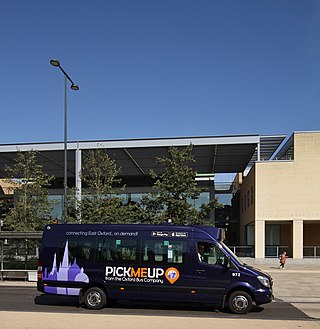
Demand-responsive transport (DRT), also known as demand-responsive transit, demand-responsive service, Dial-a-Ride transit, flexible transport services, Microtransit, Non-Emergency Medical Transport (NEMT), Carpool or On-demand bus service is a form of shared private or quasi-public transport for groups traveling where vehicles alter their routes each journey based on particular transport demand without using a fixed route or timetabled journeys. These vehicles typically pick-up and drop-off passengers in locations according to passengers needs and can include taxis, buses or other vehicles. Passengers can typically summon the service with a mobile phone app or by telephone; telephone is particularly relevant to older users who may not be conversant with technology.

The Red Deer Transit Department is part of the Community Services Division of the City of Red Deer, which lies midway between Calgary and Edmonton in the province of Alberta, Canada. The city took over operation of the public transit system from private operators in 1966. In 2009 transit service was extended to Springbrook and Gasoline Alley in Red Deer County. In 2014 transit service was extended to Blackfalds and Lacombe to the north. In 2019 transit service was extended to Penhold and Innisfail. In mid 2019 the City of Red Deer announced plans to engage in improvements to the transit network.
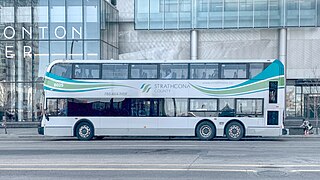
Strathcona County Transit provides local, commuter, and school bus services to the community of Sherwood Park, Alberta, Canada, which is east of Edmonton in Strathcona County. Transportation for elderly citizens and people with disabilities is provided by Mobility Bus within Sherwood Park and rural Strathcona County. Strathcona County is home to Alberta's first fleet of double-decker buses. It purchased 24 double-decker buses from 2010 to 2020 using a combination of municipal, provincial, and federal funding. In 2023, the system had a ridership of 1,274,700.

St. Albert Transit (StAT) is the public transportation system in the city of St. Albert, Alberta, Canada, which is located about 15 kilometres (9.3 mi) northwest of downtown Edmonton. Scheduled bus service consists of local circuits within the community and express commuter routes to Edmonton. The city owns and maintains the vehicles but the drivers are privately contracted from Diversified Transportation.

Public transport bus services are generally based on regular operation of transit buses along a route calling at agreed bus stops according to a published public transport timetable.

Medicine Hat Transit is the municipal public transportation system operated by Medicine Hat, a small city in southeastern Alberta, Canada. Service is available and accessible to all residents of the community, including specialized transit for persons with disabilities; all of the MHT fleet is fully wheelchair-accessible.

Needles Area Transit (NAT) is the public transportation system, including a Dial-a-Ride program for seniors and persons with disabilities, serving residents of the City of Needles in San Bernardino County, California. The NAT system transports approximately 34,000 riders each year.

Public transport is a system of transport for passengers by group travel systems available for use by the general public unlike private transport, typically managed on a schedule, operated on established routes, and that may charge a posted fee for each trip. There is no rigid definition of which kinds of transport are included, and air travel is often not thought of when discussing public transport—dictionaries use wording like "buses, trains, etc." Examples of public transport include city buses, trolleybuses, trams and passenger trains, rapid transit and ferries. Public transport between cities is dominated by airlines, coaches, and intercity rail. High-speed rail networks are being developed in many parts of the world.
A reduced fare program refers to special programs providing particular passengers with a discounted fare option for travel on a public transport system. In the United States, public transportation systems that receive federal funding are required to offer, at minimum, half fares to the elderly and handicapped persons during off peak travel. Some transportation systems also extend reduced fare options to youth, students, military personnel, and low-income passengers.
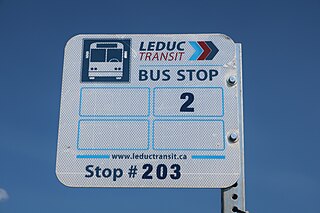
Leduc Transit is public bus system operated by the City of Leduc and Leduc County in the Edmonton Capital Region of Alberta, Canada. The service began on September 8, 2014. The capital investment was 5.16 million dollars CAD. GreenTRIP, a provincial fund to assist public transportation projects, has contributed 3.44 million dollars CAD. The remainder will be divided 65-35 between the City and the County respectively. In 2023, the system had a ridership of 111,900.

















